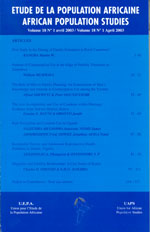
|
African Population Studies
Union for African Population Studies
ISSN: 0850-5780
Vol. 33, No. 2, 2019, pp. 4913-4926
|
 Bioline Code: ep19024
Bioline Code: ep19024
Full paper language: English
Document type: Research Article
Document available free of charge
|
|
|
African Population Studies, Vol. 33, No. 2, 2019, pp. 4913-4926
| en |
Population & development in Africa with special regards to ageing.
Muza, Collet & Mangombe, Kudzaishe
Abstract
Background: Population ageing is a global trend of the 21st century, with huge socioeconomic implications. Yet Africa’s population ageing is not fully understood. Africa is often characterized as a homogenous region which is not useful in terms of policy formulation.
Data and methods: The purpose of this study is to examine regional population ageing differentials and similarities in Africa. Selected indicators and determinants of population ageing were taken from World Population Prospects (2017) for periods 1995-2000, 2010-2015 and 2025-2030.
Findings: We applied k-means clustering method to selected indicators and grouped the countries according to their heterogeneity and homogeneity. Three clusters were identified with high, medium and low population ageing.
Conclusion: Northern and Southern African countries formed a relatively homogeneous spatial unit with the highest ageing. Each cluster forms a spatial unit in which appropriate policy measures on population development and ageing can be formulated, implemented and shared as recommended by Agenda 2030, for Sustainable Development Goals (SDGs).
Keywords
demographic revolution; regional differences; clustering
|
| |
© Copyright [2019] - African Population Studies
Alternative site location: http://www.uaps-uepa.org
|
|
